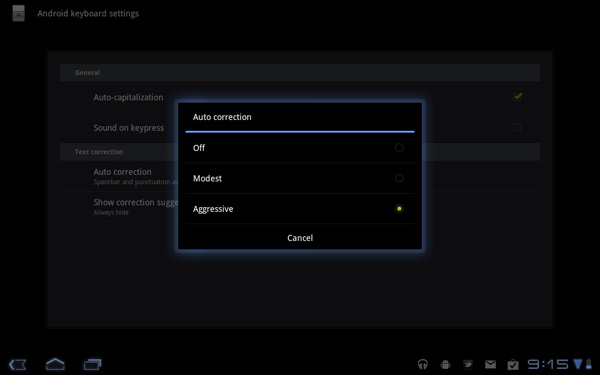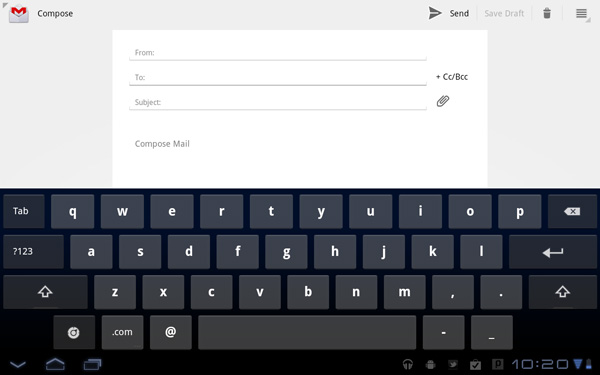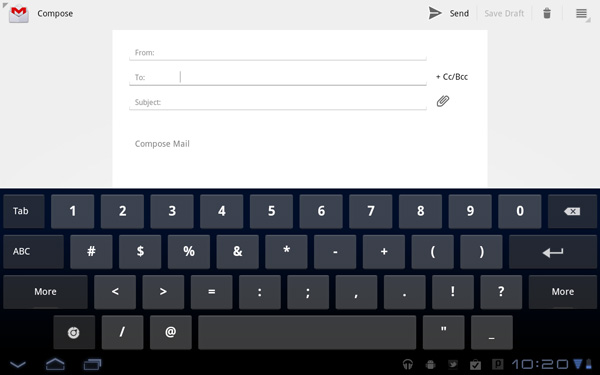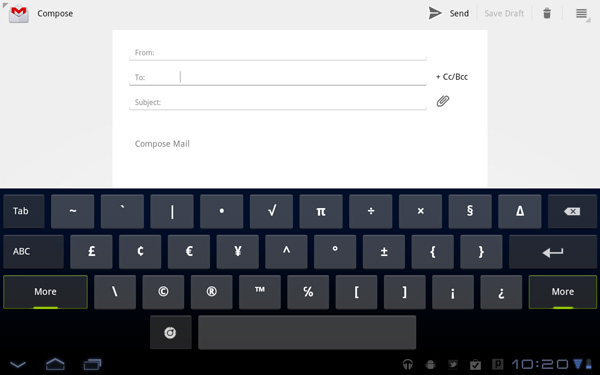Motorola Xoom Review: The First Honeycomb Tablet Arrives
by Anand Lal Shimpi on February 23, 2011 11:57 PM ESTThe Android Tablet Keyboard
In our iPad review I complained that Apple purposefully turned down the autocorrect aggressiveness, which resulted in a more frustrating typing experience than on the iPhone. Google clearly struggled with the same decision, but left the option up to the end user to configure. There’s a new option in the input device settings to set how aggressive you want the autocorrect to be:
The main difference between moderate and aggressive seems to boil down to spatial recognition for typing errors. On Android and iOS the keyboard looks at the length of the word you’re typing, letters involved as well as the location of the letters selected when comparing to the built in dictionary. In my experience, Android tends to look more at word length and letters involved than it does the physical location of the keys you’re pressing. I’m not actually sure how much Android does the latter, but iOS seems to rely on it pretty heavily. Setting Honeycomb’s autocorrect to aggressive makes the Android keyboard behave a lot more like the iOS keyboard in this regard.
The main issue with aggressive autocorrect is when you’re intentionally typing a word that’s not in the dictionary. Aggressive autocorrect will typically correct it while moderate autocorrect won’t. I’ll give you an ironic example: the name Xoom.
With autocorrect set to moderate, Honeycomb will let you type Xoom without complaining. Set to aggressive, Honeycomb will look at the location of the letter X on the keyboard, realize it is close to the letter Z and assume you meant to type Zoom.
At the same time, where aggressive autocorrect comes in handy is when you actually make a spelling mistake due to a misplaced tap. Take the word "pool". If you accidentally type "pook", moderate autocorrect won’t do anything to the word. It’ll realize it’s not in the dictionary but it is not a blatantly misspelled version of another word. Aggressive autocorrect will realize that the letter k is next to the letter l on the keyboard, assume you meant “pool” and make the substitution.
Google also lets you disable autocorrect entirely but I’m not personally a fan. I’m torn as to what method I prefer on a tablet. Both can be frustrating at times but for different reasons. I feel like aggressive autocorrect is the best option if you have a mature dictionary to check against. By mature I don’t mean that it contains words of mature content, but rather it knows all of the words that you type frequently.
By default, Honeycomb takes a simplistic approach to autocorrection: the suggested words bar is hidden. Unfortunately this means there’s no quick and easy way to manually add words to the dictionary. Thankfully Google lets you show the suggestion bar all the time if you’d like, or only when in portrait mode if that tickles your fancy. Based on what I’ve seen I’d recommend using aggressive auto correct once you’ve added a significant number of words to the dictionary.
The virtual keyboard itself is pretty nice. Key spacing is good both in portrait and landscape modes and the learning curve isn’t too steep. It’s still faster (and less painful) to type on a physical keyboard, but for banging out short messages, emails and URLs - the virtual keyboard works.
My only real complaint about the virtual keyboard is the location of punctuation keys. Google gives you access to commonly used punctuation (comma, question mark, exclamation point) without switching keyboard modes, but the position of the punctuation keys takes some getting used to - they don’t cleanly map to where you’d find them on a normal QWERTY keyboard. I feel like for first time users Apple got the layout a little better, but the point is moot - as long as you don’t go back and forth between an iPad and a Xoom you’ll get used to it.














112 Comments
View All Comments
Mumrik - Thursday, February 24, 2011 - link
I'm still waiting for the whole tablet market to implode when users realize that the products makes absolutely no sense at all for 90+% of users and that they're damn expensive for what you get.tomas986 - Thursday, February 24, 2011 - link
I see quite a few people with this opinion. I'm curious to understand why they think that way...The way I figured it, there are two types of digital experience with computers/laptops/tablets/smartphones. I think they call it "media content consumption" and (I assume) "content creation". Content creation is when you have to input data (ie... writing a paper, report, writing emails, creating pics, videos, ...). Content consumption is just reading and viewing the media content.
So, you have to ask yourself, for your computer/laptop/tablet/smartphone usage, how much time do you consume content and how much time do you create content. To understand the potential for tablets, I think you really have to break it down into the two categories.
At work, I do a lot of contest creation, but at home, about 90% of the time, i am just consuming content (read email, surf web, play game,...). Also, on the road/trip/vacation, it is mostly content consumption too.
Tablets are great for content consumption and light content creation (emails, ...), which I believe most people do about 90% of the time away from work (and some people 90% at work too :) ).
So, the tablet is design to satisfy 90% of your computer-related needs away from work. Not to mention, for content consumption, it is a better user experience than computer/laptop (due to touch screen nature).
BTW, I play computer games, so definitely still need a computer. But for me, having a computer and a tablet is much better than a computer and a laptop. Note, the computer is always there, and the tablet can't replace that (for now).
Again, I think you really have to break down your digital/computer experience between consumption and creation. Then it makes more sense for tablet usage.
Impulses - Friday, February 25, 2011 - link
That's just you though... Like me you'd never give up your desktop, but the vast majority of consumers today just have one laptop, and that's it. For most a phone is basically a necessity, and smartphones have exploded because of heavy subsidies and increased functionality, but a lot of people don't need one either.Regardless, when it comes down to spending $800 on a tablet or a new laptop, they're gonna go w/the laptop (possibly a cheaper one at that)... So the tablet remains a luxury item that can't fully replace their main system, nor their secondary device (phone). If these tablets were priced way lower they'd make a lot more sense as a supplementary device, and I'm sure we'll get there eventually...
Right now most people are better served w/something like a Brazos-based ultra-portable tho. Having a tablet on top of that is great for couch use or traveling if you opt for a large laptop, but it's just a luxury item. They've tried to make newspapers and magazines the killer tablet app and I don't think it's catching on much. People that read a lot still prefer an e-reader (or an actual computer if they need to do research/etc.).
strikeback03 - Thursday, February 24, 2011 - link
Anand drives a Camry? I would have expected something more like a BMW or Audi.As far as the screen contrast goes, I find it funny that 750:1 is considered a downside here, while the notebook editors celebrate anytime they find a screen that even hits 500:1.
shadowofthesun - Thursday, February 24, 2011 - link
"I’d love to see a quick search field here so you could just start typing to find the app you’re looking for but perhaps we’ll see that in a future version of the OS."On my Android 2.1 device, typing while in the applications drawer brings up a quick search box which does indeed search apps on the phone.
I vaguely remember my previous motoblur 1.6 device actually filtering the apps if I typed on the physical keyboard, but I can't confirm that ATM.
strikeback03 - Friday, February 25, 2011 - link
plus didn't the page for the google search box show it bring up the app Angry Birds as the first result?ltcommanderdata - Thursday, February 24, 2011 - link
http://www.flickr.com/photos/26574892@N07/54752576...Interestingly, Motorola designed the Xoom's primary product page around Flash, probably to exclude the iPad, but it ironically means the Xoom can't view it yet either.
mrdeez - Friday, February 25, 2011 - link
I will definitely get one of these wifi only when released.....Great fair review. What this unit has going for it IMO,and other android device makers should pay attention to is Battery life. I love my evo but i get anywhere from 5-8 hours on it depending on what i'm doing. I really think ability to actually use these devices without having to charge the battery all the time is a big advantage. Most of the hardware/software quirks will be fixed soon as this is googles developer tablet.chomlee - Friday, February 25, 2011 - link
This is my take away from all of this, and keep in mind, I am not an apple fanboy. My favorite phone is the EVO.My most important factors in a tablet
Best screen - Apple
Best Load time - Xoom
Best UI - Xoom (considering deficencies will be fixed with future android releases)
Battery Life - Tie
Pricing - Apple
Overall, to me it is a tie right now but that is with the current IPad. The next IPad will probably catch up to the the Xoom on most of the benefits and the only benefit of the Xoom may be Honeycomb.
Another factor not mentioned that is really important to me is how you can turn on your 3G service a month at a time and use it on vacations when you need to. I would never get a contract on a tablet device because it would mostly be used at home on the wifi (I think most people are in the same boat). That option is a deal breaker for me.
I would love to have an android device but I have a feeling that the Ipad 2 is going to be even better at a lower price than the xoom, I may end up being one of those drones buying the new IPad.
bplewis24 - Tuesday, March 1, 2011 - link
You forget that there will only be one new iPad releasing this year (most likely), but there will be several Honeycomb tablets emerging on the market. Some will have better screens (Asus Transformer?), some will have better pricing (Galaxy Tab 10.1?), and yet others will have better feature sets ...all while still having the same best-in-class Honeycomb UI.So, while the iPad2 may possibly catch up or even surpass the Xoom on some level, that will be it for the rest of the year, while other Honeycomb tablets will still be shooting for the crown, driving Honeycomb tablet pricing down in the process.
Brandon